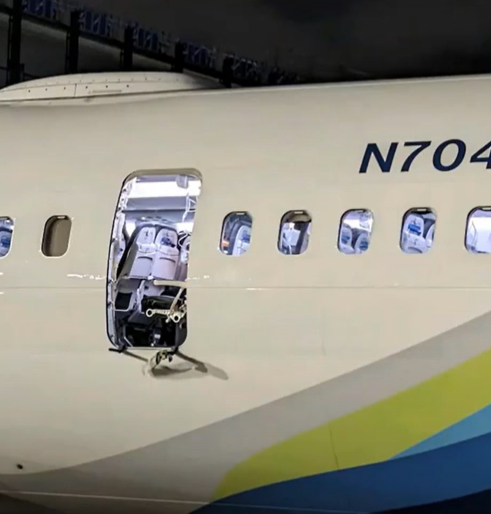By the Leeham News Team
Analysis
Jan. 8, 2024, © Leeham News: Following in the footsteps of the 737 rudder bolt omission inspection just last month, we have the Jan. 5 incident on Alaska Airlines Flight 1282 in which an emergency exit plug door blew off the airplane at 16,500 ft. This may indicate another quality assurance failure at either Boeing or Spirit AeroSystems.

The door plug design used on the Boeing 737-900/900ER, 737-8-200 and 737-9. Credit: Boeing, via the National Transportation Safety Board.
We don’t know if this is a Boeing problem, a Spirit problem, a bolt manufacturer problem, or an Alaska Airlines problem. It’s way too soon in the investigation to draw conclusions. Certainly, because it’s Boeing’s name on the airplane, and especially given the MAX history, people are jumping to the conclusion that Boeing screwed up again. While this may ultimately prove true, LNA is not at all prepared to conclude today that this is the case.

Illustration of the bolt locations securing the Boeing 737-9 door plug to the airframe. Credit: Capt. Chris Brady.
The flight left Portland (OR) for Ontario (CA) about 4:30pm. Six minutes later, as the two-month-old Boeing 737 MAX 9 was climbing through 16,500 ft to cruising altitude, the inactive emergency exit plug door, aft of the wing on the left side of the plane, separated from the aircraft. Decompression followed, with an emergency descent and landing back at Portland. There were no serious injuries.

The area where the door plug and cell phones fell from Alaska Airlines Flight 1282. Credit: Google Earth, NTSB.
Boeing and Spirit have been plagued in recent years by quality “escapes.” Inspection and quality assurance may be the culprit again. The official investigation will take some time. The rapid issuance of the Emergency AD Note mandating only a one time inspection is a logical response to something having been misassembled, with the fix being to verify it is assembled per drawing. Whether this is another piece of poor workmanship not being caught by inspection remains to be seen.
The following analysis was compiled by LNA’s news team.
Incomplete Picture
There is an incomplete picture of the factors leading to Flight 1282’s incident. But initial suspicion suggests this may be another inspection “escape,” whether at Boeing or Spirit.

But it’s important to note that the National Transportation Safety Board (NTSB) will look beyond Boeing and Spirit. Were the bolts subject to a manufacturing defect that caused a failure? Did Alaska have occasion to open the door plug between the time the airplane was delivered on Oct. 31 and entered service on Nov. 11? If so, was it reinstalled correctly?
Related article
Alaska’s maintenance partner didn’t use the door plug for wi-fi work: Bloomberg
A door plug departed the aircraft, leading to depressurization, an emergency descent, and an emergency landing. Nobody was seated next to the door or the adjacent middle seat. The teenager’s shirt was ripped off in the incident, but the passenger apparently was uninjured. Oxygen masks deployed.
Pictures of the aircraft post-accident show the door appeared to leave the plane cleanly, with only minor damage to the door surround. A prime candidate for the cause of the incident seems to have been identified as door locking bolts. There has been an Emergency Airworthiness Directive issued by the Federal Aviation Administration for inspection of the MAX 9’s door plug. The affected MAX 9s are grounded until the inspection and any fix are completed. The process takes 4-8 hours.

Exterior view of Alaska Airlines Boeing 737-9, N704AL. The door plug appears to have separated cleanly. Credit: Capt. Chris Brady.
The FAA issuing the corrective action quickly seems to have tacitly indicated that the cause has been identified and corrected.
Examining the damage
The aircraft door departed the aircraft without any real damage to the structure being apparent in the photos. It looks like the door was released from the aircraft without disturbing the mounting lugs. This could be explained by the omission of the bolts securing the door against vertical movement that would allow the plug door to “unlatch” from the structure and be blown free of the aircraft as it depressurizes.
This would also explain the lack of visible door jamb damage. We don’t know why the door left the aircraft, but we do know that its departure could not occur unless one or more of the four corner bolts were missing.
If this is all true, and we see no other reasonable explanation, this is yet another inspection escape. The photographs of fuselages on railcars coming to Boeing from Spirit show these doors installed, but they may be subsequently removed and reinstalled at Renton, so there is some question of whose inspection system is the root cause.

The interior view of Alaska Airlines Boeing 737-9, N704AL, where the door plug had been. Credit: Capt. Chris Brady.
Capt. Chris Brady, a UK 737 pilot, created a video examining the plug door in response to the 1282 incident. for the information found on his video. The video at the 21:45 mark describes the AS1282 incident in detail.
Inspection procedures
We know from experience with the production paper at Boeing that there are four levels of inspection commonly employed on each “Operation and/or Job.”
Manufacturing Verify
The first level of scrutiny is “Manufacturing Verify”. This means that a manufacturing employee who is not a member of the Quality Organization may sign the operation off as complete as the complexity of the operation or the potential for a defect poses minimal risk of downstream problems.
An example of this would be the drilling of non-close tolerance holes, installation of secondary structure items like covers and fairings, carpets, cabin sidewalls, and things that have a tolerance window that is easily accomplished by the mechanic where an occasional error does not compromise the product.

Manufacturing Lead Verify
The Second level of scrutiny is “Manufacturing Lead Verify”. This applies a second set of manufacturing eyeballs on the operation to make sure the task is accomplished correctly in cases where a Quality Assurance Verify is not deemed to be necessary.
QA Verify
The Third level of scrutiny is QA Verify. This is a traceable inspection where a specific task is inspected by a member of the Quality organization.
Due to the number of QA inspectors on the floor and the incredible number of jobs being closed daily off the Control Code Bar Charts, not as many jobs as you may think actually get a QA Verify operation inserted in them.
QA Verify is reserved for situations where the risk of a manufacturing error would have an unacceptable outcome on the product. We also need to be clear on the difference between a QA Verify operation in the workflow (operations) portion of a job, and the QA Verify Job Complete at the end of a job.
QA Verify ops in the job means a set of QA eyeballs is looking at the airplane. QA Verify Job Complete is a bookkeeping step where the inspector, looking at the paperwork, makes sure it’s all stamped off correctly by manufacturing and is ready to be filed as completed.
Customer Verify
Finally, we have the holy grail of inspections, Customer Verify. This inspection step is applied to the job at the request of the customer who decides what they wish to inspect. This places customer representative eyeballs inside the build process where they think they need to observe the build process. That stacks 3 sets of eyeballs on a specific item, Mechanic, QA, and Customer.
FAA Surveillance
Now we overlay the FAA into the process. Every job in the factory is checked by the FAA on a statistically based periodic basis using job complexity and bad outcome risk to drive what is reviewed when. Here we need to make the distinction that the Job Content is reviewed, not its use on each airplane.
The FAA also has periodic inspections of the production system itself where their personnel look into all aspects of the production system to make sure that the approved system is functioning as it was certified.
Internal Oversight
Boeing provides internal oversight of its production system: Quality Planning is an organization inside Boeing that reviews each job at its time of creation to make sure that all the process specifications, standard work instructions, and correct levels of inspection are applied in a logical manner to the jobs. They also periodically review the production systems job library to make sure no job maintenance changes made have allowed the job to drift off point.
Understanding how many people are involved in the creation of a robust Production System and its surveillance program, we finally get to ask the pointy questions.
Outstanding Questions
- Are Inspection Escapes occurring more often now than in the past, or is the media more efficient in reporting them?
- If there are more inspection escapes, is the loss of assembly worker/inspector skill tied to the problem, and to what degree?
- If we had an inspection escape in a process where two different sets of eyeballs stamped the paperwork saying they saw the work properly executed, what influenced the workers to make their errors at the same time?
- Looking at the highly configured nature of Boeing’s aircraft, will inspection escapes ever end, or will we just have to accept that good enough will have to be good enough and some level of human error is inevitable?
Boeing to date hasn’t conveyed answers to these questions to the flying community, as far as LNA knows. In fairness to Boeing, Transport Category Commercial Aircraft are very complex. These are highly variable products that have few similarities with any other production system. No other product being made today has near the safety of flight/operation regulation package that aircraft do. Even at that, Boeing must improve this sticky issue, and there are no clear-cut immediate paths forward.
Related

